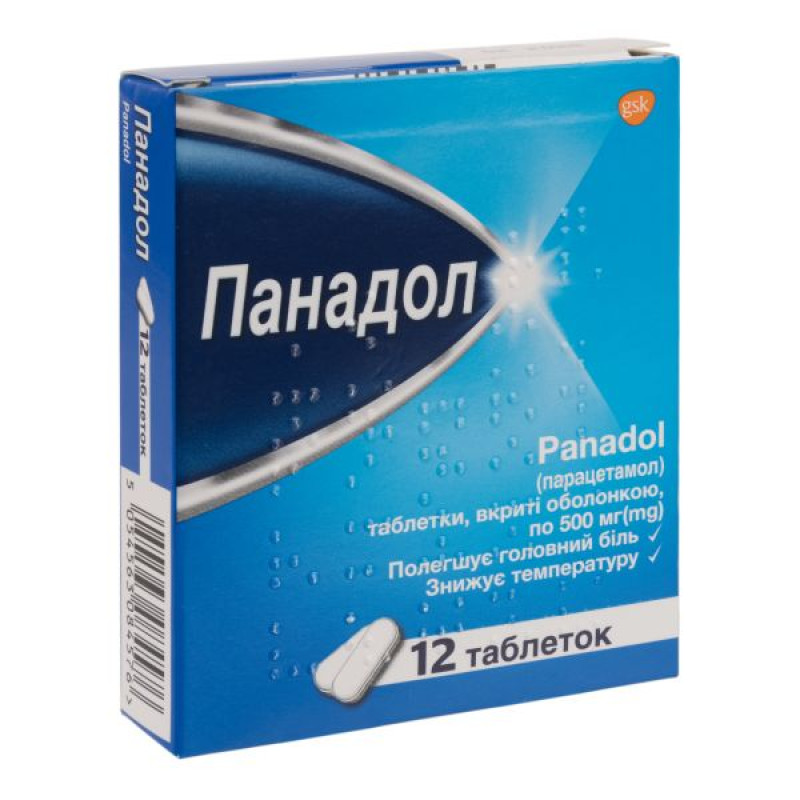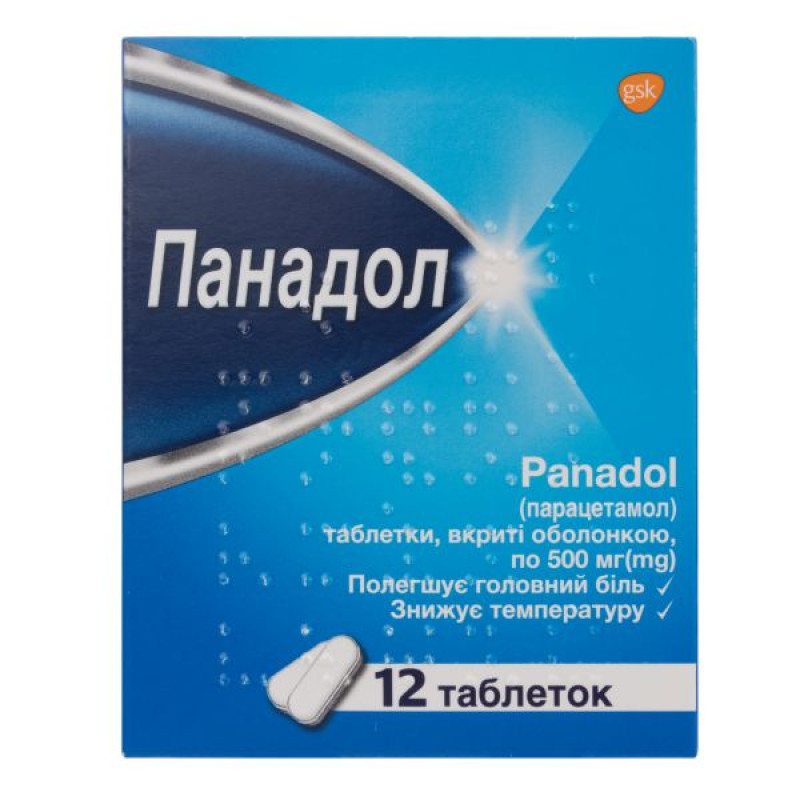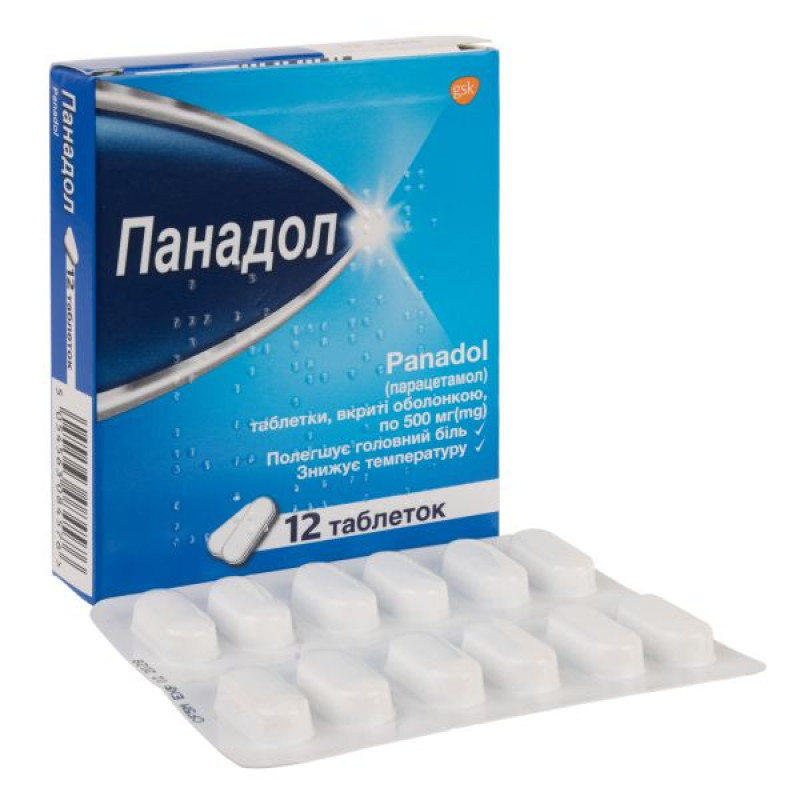Panadol film-coated tablets 500 mg No. 12

Instructions Panadol film-coated tablets 500 mg No. 12
Composition
active ingredient: paracetamol;
1 tablet contains 500 mg of paracetamol;
Excipients: corn starch, pregelatinized starch, povidone, potassium sorbate, talc, stearic acid, hypromellose, glyceryl triacetate, carnauba wax.
Dosage form
Film-coated tablets.
Main physicochemical properties: white, film-coated tablets with flat edges, embossed with a triangular logo on one side and a break line on the other.
Pharmacotherapeutic group
Analgesics and antipyretics. Anilides. Paracetamol. ATX code N02B E01.
Pharmacological properties
Pharmacodynamics
Panadol tablets contain paracetamol, an analgesic and antipyretic (pain reliever and antipyretic). The effect is based on the inhibition of prostaglandin synthesis in the CNS.
Pharmacokinetics
Paracetamol is rapidly and almost completely absorbed from the gastrointestinal tract and distributed to most body tissues. Binding of paracetamol to plasma proteins is minimal when administered in therapeutic doses.
Paracetamol is metabolized mainly in the liver and excreted in the urine as transformation products. The average half-life of paracetamol in blood plasma after oral administration is about 2.3 hours.
Indication
Short-term treatment of headache, toothache, muscle pain, menstrual pain, moderate osteoarthritis pain, fever symptoms and pain from colds and flu.
Contraindication
Hypersensitivity to the components of the drug, severe liver and/or kidney dysfunction, congenital hyperbilirubinemia, glucose-6-phosphate dehydrogenase deficiency, alcoholism, blood diseases, Gilbert's syndrome, severe anemia, leukopenia. Age up to 6 years.
Interaction with other medicinal products and other types of interactions
The rate of absorption of paracetamol may be increased by metoclopramide and domperidone and decreased by cholestyramine. The anticoagulant effect of warfarin and other coumarins with an increased risk of bleeding may be enhanced by concomitant long-term use of paracetamol. Intermittent administration has no significant effect. Barbiturates reduce the antipyretic effect of paracetamol.
Anticonvulsants (including phenytoin, barbiturates, carbamazepine), which stimulate the activity of liver microsomal enzymes, may enhance the toxic effect of paracetamol on the liver due to an increase in the degree of conversion of the drug to hepatotoxic metabolites. With the simultaneous use of paracetamol with hepatotoxic drugs, the toxic effect of the drugs on the liver increases. The simultaneous use of high doses of paracetamol with isoniazid increases the risk of developing hepatotoxic syndrome.
Paracetamol reduces the effectiveness of diuretics. Do not use simultaneously with alcohol.
Application features
The drug contains paracetamol, so it should not be used together with other drugs containing paracetamol and used, for example, to reduce fever, treat pain, flu and cold symptoms or insomnia. Simultaneous use with other drugs containing paracetamol may lead to overdose. Overdose of paracetamol can cause liver failure, which may require a liver transplant or be fatal.
If you have liver or kidney disease, you should consult a doctor before using the drug.
It should be taken into account that patients with liver diseases have an increased risk of hepatotoxic effects of paracetamol.
Cases of liver dysfunction/liver failure have been reported in patients with reduced glutathione levels, such as those with severe wasting, anorexia, low body mass index, chronic alcoholism, or sepsis.
Patients with reduced glutathione levels are at increased risk of metabolic acidosis when taking paracetamol. Symptoms of metabolic acidosis include deep, rapid or labored breathing, nausea, vomiting, and loss of appetite. You should seek immediate medical attention if these symptoms occur.
If symptoms persist, consult a doctor. Prolonged use without medical supervision may be dangerous.
The medicine should be used only when clearly necessary.
Keep the drug out of the sight and reach of children.
Ability to influence reaction speed when driving vehicles or other mechanisms
Does not affect.
Use during pregnancy or breastfeeding
As with all medicines, consult your doctor before taking paracetamol during pregnancy. A large amount of data on pregnant women indicate neither malformative nor feto/neonatal toxicity. Epidemiological studies on the development of the nervous system in children exposed to paracetamol in utero have not yielded conclusive results. If clinically necessary, paracetamol can be used during pregnancy, but it should be used at the lowest effective dose for the shortest duration and with the least possible frequency.
Paracetamol is excreted in breast milk, but in clinically insignificant quantities when used in recommended doses. Available published data do not rule out the possibility of taking the drug during breastfeeding.
Method of administration and doses
The drug is intended for oral administration.
Do not exceed the recommended dose. The lowest dose of the drug necessary to achieve the treatment goal should be used.
Adults and children over 12 years of age: 1–2 tablets up to 4 times a day (every 4–6 hours) as needed.
The interval between doses is at least 4 hours.
You should not take more than 8 tablets (4000 mg) in 24 hours.
Children (6–11 years): ½–1 tablet up to 4 times a day (every 4–6 hours) as needed.
The maximum period of use for children without consulting a doctor is 3 days.
You should not take more than 4 doses in 24 hours.
The interval between doses is at least 4 hours.
Children
Not recommended for use in children under 6 years of age.
Overdose
Paracetamol overdose can cause liver failure, which may require liver transplantation or be fatal. Experience shows that clinical signs of liver damage following paracetamol overdose usually appear 24–48 hours after the overdose and reach a maximum after 4–6 days.
There is an increased risk of paracetamol poisoning, particularly in elderly patients, children, patients with liver disease, chronic alcoholism, and chronic malnutrition.
Symptoms of overdose in the first 24 hours: pallor, nausea, vomiting, loss of appetite and abdominal pain, asymptomatic overdose is also possible.
Paracetamol overdose in adults or children with a single dose can cause reversible or irreversible necrosis of liver cells, which can lead to impaired glucose metabolism, metabolic acidosis, hepatocellular failure, encephalopathy, hemorrhage, hypoglycemia, coma and death. At the same time, there is an increase in the level of hepatic transaminases (AST, ALT), lactate dehydrogenase and bilirubin, as well as the level of prothrombin, which occurs 12-48 hours after ingestion. Liver damage is likely in adults who have taken a larger than recommended amount of paracetamol. It is believed that the increased amount of paracetamol metabolite (which is usually neutralized by the action of glutathione when using normal doses of paracetamol) binds irreversibly to liver tissue.
Acute renal failure with acute tubular necrosis may present with severe back pain, hematuria, and proteinuria, and may occur even in the absence of severe liver damage. Cardiac arrhythmias and acute pancreatitis, usually accompanied by liver dysfunction and hepatotoxicity, have also been reported.
With prolonged use of the drug in high doses, aplastic anemia, pancytopenia, agranulocytosis, neutropenia, leukopenia, thrombocytopenia may develop from the hematopoietic system. When taking large doses, dizziness, psychomotor agitation and disorientation are possible from the central nervous system; nephrotoxicity (renal colic, interstitial nephritis, capillary necrosis) is possible from the urinary system.
Symptoms may be limited to nausea and vomiting or may not reflect the severity of the overdose or the risk of organ damage.
Risk factors for paracetamol overdose include:
long-term treatment with carbamazepine, phenobarbitone, phenytoin, primidone, rifampicin, St. John's wort and other drugs that induce the synthesis of liver enzymes; regular alcohol abuse; reduced glutathione levels, for example, in eating disorders, fasting, exhaustion, cystic fibrosis, HIV.
In case of overdose, immediate medical attention is required. Treatment of overdose or even suspected overdose should be started immediately, for which the patient should be taken to hospital, even if there are no early symptoms of overdose, since liver damage may not develop immediately. The concentration of paracetamol in the blood plasma should be measured 4 hours or later after ingestion (earlier concentrations are unreliable).
Treatment with activated charcoal should be considered if an overdose of paracetamol greater than 150 mg/kg has been taken within 1 hour. Treatment with N-acetylcysteine or methionine should be considered. Symptomatic treatment should also be provided.
Adverse reactions
Immune system disorders: (rare: < 1/10,000) - anaphylaxis, hypersensitivity skin reactions including skin rash, angioedema, Stevens-Johnson syndrome and toxic epidermal necrolysis.
Respiratory, thoracic and mediastinal disorders: (rare: < 1/10,000) - bronchospasm in patients sensitive to acetylsalicylic acid and other non-steroidal anti-inflammatory drugs.
From the hepatobiliary system: (rare: < 1/10,000) - liver dysfunction.
Also, after taking drugs containing paracetamol, the following side effects are possible: skin itching, exudative erythema multiforme, nausea, epigastric pain, hypoglycemia, up to hypoglycemic coma, agranulocytosis, anemia, sulfhemoglobinemia and methemoglobinemia (cyanosis, shortness of breath, heart pain), hemolytic anemia, bruising or bleeding, increased activity of liver enzymes, usually without the development of jaundice.
Expiration date
5 years.
Storage conditions
Store at a temperature not exceeding 25 ºС, out of the reach and sight of children.
Packaging
12 tablets in a blister, 1 blister in a cardboard box.
Vacation category
Without a prescription.
Producer
GlaxoSmithKlineDungarvanLimited, Ireland.
SmithKlineBeecham SA, Spain.
Location of the manufacturer and its business address
Knockbrack, Dungarvan, Co. Waterford, Ireland.
Ctra. de Ajalvir, Km. 2.500, Alcala de Henares 28806 (Madrid), Spain/Ctra. de Ajalvir, Km. 2.500, Alcala de Henares 28806 (Madrid), Spain.
There are no reviews for this product.
There are no reviews for this product, be the first to leave your review.
No questions about this product, be the first and ask your question.





